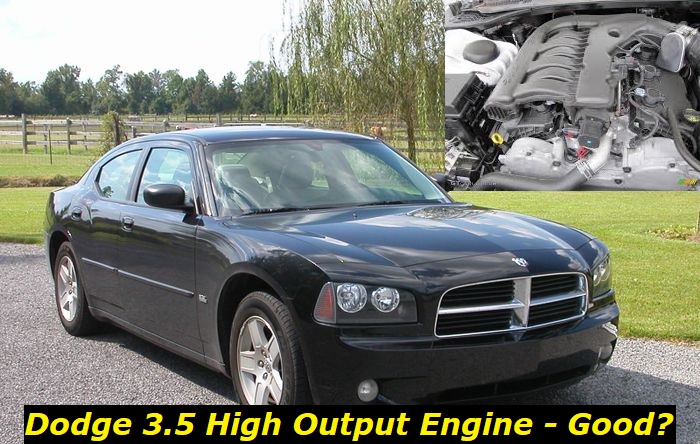There were high hopes for the Dodge 3.5L V6 engine when it came out. Its initial version was touted as a major upgrade from the 3.3L V6, which was considered to be a highly reliable engine for its time. Therefore, expectations were up as it was introduced in 1993 and when its High Output version was consequently rolled out in 1998.
Chrysler, however, has missed its mark on the engine as numerous complaints piled up on its rap sheet. Fast-forward to the present moment, it is now seen as one of the lost opportunities on the part of the automaker and a good money pot for today's engine rebuilders.

Key facts and my opinion about the engine
- Production years: 1998-2010
- Average lifespan of 3.5 HO: 210,000-230,000 miles
- Fuel supply type: port injection (sequential)
- Power range: 247-253 hp
- Fuel efficiency: below average
- Engine block material: aluminum
- Engine reliability score: high
- The most common problems: poor lubrication due to thin oil channels, uneven idling, contaminated throttle, EGR, and exhaust valves.
Most Common Problems Found in the Dodge 3.5 High Output Engine
The Dodge 3.5 High Output engine was definitely a major letdown for many fans of its brand due to several problems that hounded it. The high expectations that came with it only added to their frustration, too. Based on reports and numerous complaints, the most common of them are the following:
1. Oil Sludging
Oil sludging is the problem that the Dodge 3.5 High Output engine is most notorious for because of the way it was designed. Aside from the development of gel-like substances in some parts of the engine, the other symptoms of this include oil leaks, low oil pressure, and engine knocking. If the problem is not addressed immediately, it can cause irreparable damage to the engine.
Oil sludging is a build-up of thick, viscous oil in the engine. This can occur for a number of reasons such as using the incorrect type of oil for your engine, not changing your oil regularly, using the wrong viscosity of oil, having an overheated and damaged engine, or cracks in the oil lines. The other possible causes of oil sludging include extended idling, regular short-tripping, and frequent drives in stop-and-go traffic.
The best way to prevent this problem is to change the oil regularly, avoid extended idling, and avoid regular short trips. If you do experience oil sludging, there are several possible solutions, including flushing the engine oil and the contaminants with a liquid solution specially made for this issue.
Meanwhile, leaks can be fixed by replacing the gasket, seals, hoses, or O-ring. Other parts of the engine may need to be changed, too, if they have been damaged due to the resulting lubrication problems.
Oil sludging can be a serious problem for your engine, so it's important to be aware of the symptoms and take immediate action to prevent it from happening or to fix it at its early stages.
2. Crankshaft Bearing Failure
A crankshaft bearing is a component of the engine that supports and lubricates the crankshaft as it rotates. The bearings are made of metal, and they can be found between the journals of the crankshaft. Crankshaft bearings are important because they aid in reducing friction between the moving parts of the engine to make it more efficient.
The symptoms of crankshaft bearing failure in the Dodge 3.5 High Output engine can include odd noises from the engine, strong vibrations, and significant oil pressure loss. If the problem is not addressed immediately, it can ultimately lead to engine damage or failure.
The possible causes of crankshaft bearing failure include lack of lubrication, which can be made worse by the oil sludging problem that the Dodge 3.5 High Output engine is infamous for. The other culprits are frequent overloading, bad driving habits, and contamination.
The solutions to the problem can include replacing the bearings, repairing the journals, and flushing the engine. In more severe instances, the journals, bearings, and other parts directly or indirectly affected may need to be replaced if they have been damaged beyond repair.
3. Crankcase Damage
The crankcase is an important part of the engine. It houses the crankshaft, bearings, and other moving parts of the unit. The crankcase also contains oil, which lubricates and cools the engine.
If the crankcase is damaged, it can cause problems like the oil sludge issue that the Dodge 3.5 High Output is known for. On the polar opposite, it can also be an aftereffect of lubrication issues. In this event, it is like debating which came first between the chicken and the egg when determining which came first between the lubrication problem and the crankcase damage.
Damage in your crankcase is likely if there are signs of oil leaks coming from its housing. This can be because of a crack in the case, a loose or broken seal, or a loose or worn gasket. Other symptoms include unusual noises from the engine, excessive vibration, and reduced power. If the damage is not addressed immediately, it can lead to worse problems such as engine failure.
The possible causes of crankcase damage include overheating, impact damage, and wear and tear. The ways to repair the problem can vary depending on the cause, but it normally involves replacing the crankshaft bearings, seals, or gaskets. It may be possible to weld shut the minor crack in the encasing as an alternative. In extreme cases though, the entire crankcase must be replaced if the damage is too impractical to be repaired.
Crankcase damage is a serious problem that can have a major impact on your engine. If you suspect that your crankcase is damaged, it is important to have it inspected by a qualified mechanic as soon as possible. Taking care of the problem early will help prevent further damage and keep your engine running smoothly.
4. PCV Valve Premature Wear
The PCV valve is an important part of the engine, as it regulates the pressure in the crankcase. When the PCV valve starts to wear out, it can be detrimental to the engine.
Some of the symptoms of PCV valve wear include decreased engine power, increased oil consumption, and increased emissions. The engine may also run rougher than usual and may produce a knocking noise. If left unaddressed, these symptoms can eventually lead to engine failure.
There are a few possible causes of PCV valve wear. One possibility is that the valve itself is simply worn out and needs to be replaced. Another is again an oil leak somewhere in the engine, which may cause oil to build up on the valve and wear it out prematurely.
If you suspect that your PCV valve is starting to wear out, it's important to act right away. The first step is to check for any oil leaks. If you find an oil leak, it's important to have it fixed as soon as possible.
In some cases, irreparable damage may have already been done to the engine and parts will need to be replaced. However, if caught early enough, replacing the PCV valve should be enough to fix the problem.
5. Overheating
If your Dodge 3.5 High Output engine is overheating, there are a few symptoms you will notice. The engine may run hotter than usual, the temperature gauge may read higher than normal, or the engine may start to make knocking or pinging sounds. If the problem is not addressed immediately, it can cause serious damage to the engine.
The probable sources of overheating may be a sludge build-up, a coolant leak, a failed water pump, a clogged radiator, or a faulty thermostat. The possible solutions for these include engine flushing, coolant replacement, water pump replacement, radiator replacement, and thermostat replacement. Depending on the severity of the problem, you may also need to replace other engine parts that have been damaged by the extreme rise in temperature.
If you notice any of these symptoms, it's important to take action right away to avoid further damage to your engine. If you're not sure what the problem is or how to fix it, take it to a mechanic so they can diagnose and repair the issue.
Longevity of the Dodge 3.5 High Output Engine
The Dodge 3.5 High Output engine came during a time when the recommended interval for changing oil was every 3,000 miles. That's way shorter than the standards set by modern lubricants nowadays that can last between 5,000 to 7,000 miles before requiring a change of oil, or even up to 15,000 miles if full-synthetic motor oil has been utilized. With that, missing the scheduled change oil increases the risk to trigger the sludge issues that may lead to a plethora of other engine problems in the Dodge 3.5 HO.
There have been conflicting reports about the durability of this engine but many of those who experienced it may agree that it may not last over 100,000 miles without the sludging issue and other major repairs. On the other hand, since most versions of the engine being used now have been rebuilt, we expect the underlying issues experienced by its factory variant to have been addressed already, or their risk has been mitigated at the very least.
Key Specs of the Dodge 3.5 High Output Engine
The 3.5L High Output engine was a tweaked version of the 3.5L released in 1993. The newer engine was first used in 1999 model year Chrysler vehicles followed by the adoption of Dodge in 2000. It featured aluminum cylinder heads and an aluminum block featuring a 96.01 mm bore and 86 mm stroke. The compression ratio of the unit was at 9.5:1 while the output went up to a total of 255 hp and 250 lb-ft of torque.
Despite the jump in power, Chrysler failed to improve the engine where it mattered most. Among the things the automaker overlooked were the seemingly underwhelming oil galley pathways of the block, its problematic coolant system, and the undersized PCV system. All of which were contributory to its sludge formation issues.
Conclusion
The Dodge 3.5 High Output engine was surely a letdown primarily because of its sludge problems that tend to trigger other more complicated issues. Thus, it is not something that we really recommend for people who are looking for replacements or swaps. However, for those who still decide to go for it, we highly advise taking a rebuilt version of it with its weak spots already attended to.
About the authors
The CarAraC research team is composed of seasoned auto mechanics and automotive industry professionals, including individuals with advanced degrees and certifications in their field. Our team members boast prestigious credentials, reflecting their extensive knowledge and skills. These qualifications include: IMI: Institute of the Motor Industry, ASE-Certified Master Automobile Technicians; Coventry University, Graduate of MA in Automotive Journalism; Politecnico di Torino, Italy, MS Automotive Engineering; Ss. Cyril and Methodius University in Skopje, Mechanical University in Skopje; TOC Automotive College; DHA Suffa University, Department of Mechanical Engineering






Add comment